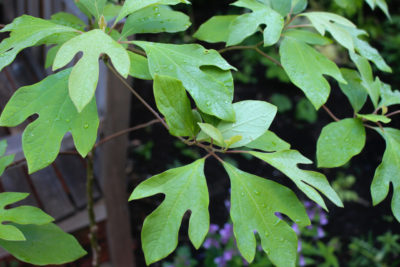Sassafras (Sassafras albidum)
Sassafras is a lovely native woodland tree that displays beauty and interest all seasons of the year and makes a wonderful addition to the home garden. The branches are gracefully layered, with horizontal branches that are wider near the bottom and gradually narrow as they near the top. In spring, delicate chartreuse flowers bloom from fat terminal buds before leaves open. Most leaves are mitten shaped – others are simple ovals or have multiple ‘fingers’.  Children delight in holding their hands against the leaves, checking the fit of mittens and gloves. A crushed leaf or broken twig releases the tree’s characteristic aroma of root beer, cinnamon, citrus, or one of those fruity breakfast cereals that I once ate. In late summer to early fall, flowers fertilized by small flies and bees give way to attractive clusters of dark blue berries that hang from bright red stalks. The leaves begin their fall display in shades of bright green-yellow, orange-pink and red-purple. In mid to late fall, leaves let go and blanket the ground with rich, vibrant color.
Children delight in holding their hands against the leaves, checking the fit of mittens and gloves. A crushed leaf or broken twig releases the tree’s characteristic aroma of root beer, cinnamon, citrus, or one of those fruity breakfast cereals that I once ate. In late summer to early fall, flowers fertilized by small flies and bees give way to attractive clusters of dark blue berries that hang from bright red stalks. The leaves begin their fall display in shades of bright green-yellow, orange-pink and red-purple. In mid to late fall, leaves let go and blanket the ground with rich, vibrant color.
Sassafras is in the laurel family, a cousin to laurel and spicebush. It is an understory plant that grows at the woodland edge or in woods following blowdown, fires, or logging. I was walking through a woodland in Massachusetts following a recent forest disturbance and was delighted to see the forest floor covered with tiny sassafras seedlings. In the wild, sassafras grows in sandy, well-drained soil in full sun to partial shade. A native to southern Maine, its range extends west to Missouri and south to central Florida. Cold winter temperatures limit the northern range of sassafras. With warming temperatures, we expect to see sassafras gradually migrate northward. Growth is rapid and trees send out root sprouts that will eventually form a compact colony.
All native plants are an important food source for wildlife. Sassafras berries are relished by black bears, wild turkeys, and many songbirds. Deer and porcupines feed on twigs and leaves, and rabbits nibble on bark in winter. Sassafras is a host plant for the spicebush swallowtail butterfly and Promethea moth, along with 36 other species of butterflies and moths.
 I have recently planted a sassafras in my yard in a part-shade corner where its bright chartreuse spring leaves and brilliant fall colors light up the garden. It grows quickly and looks beautiful amid the asters and goldenrods. I can’t wait to share the secrets of sassafras with my grandchildren. For now, I’ll just have a bowl of that fruity breakfast cereal.
I have recently planted a sassafras in my yard in a part-shade corner where its bright chartreuse spring leaves and brilliant fall colors light up the garden. It grows quickly and looks beautiful amid the asters and goldenrods. I can’t wait to share the secrets of sassafras with my grandchildren. For now, I’ll just have a bowl of that fruity breakfast cereal.
Growing sassafras: Plant small sassafras trees that have been seed grown in containers by a reputable native plant grower, avoiding cultivated varieties. You can grow your own sassafras trees from freshly collected seed – it is easy to grow, and small plants adapt better to transplanting from containers. To support genetic diversity, collect seeds from several trees. Sassafras has male and female flowers on separate trees ( called ‘dioecious’ meaning ‘two houses’), so male trees will not produce seeds. The seed needs to be cleaned from the fleshy berry and kept moist before planting. Sassafras requires a cold period to germinate. Plant seeds in containers in fall and watch for sprouting the following spring. Seeds can be planted directly in the ground, in shade, but be sure to mark the area (I use a section of low fencing, folded into a triangle), and make sure the soil does not dry out. Sassafras, like all native trees, should never be dug from the wild. It does not tolerate transplanting due to a deep tap root.
Herbal uses of Sassafras: All parts of sassafras have been used by Native Americans for food and medicine to treat a variety of illnesses and conditions. Leaves are crushed and made into teas and poultices. Tea, made from steeped root or root bark, has long been valued as an all-round remedy, such as we use witch hazel. Until the early 1900’s, sassafras tea mixed with milk and sugar, a popular drink called “saloop” was found on every street corner of England. File, a powder made of ground sassafras leaves, is a key flavoring ingredient in Louisiana gumbo.
By Ginger Laurits
Ginger Laurits is a Wild Seed Project board member and a master gardener who tends the native garden at the Wells Reserve.

